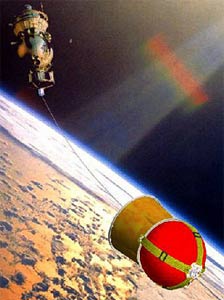Thank you very much for visiting Gunter's Space Page. I hope that this site is useful and informative for you.
If you appreciate the information provided on this site, please consider supporting my work by making a simple and secure donation via PayPal. Please help to run the website and keep everything free of charge. Thank you very much.
YES2

YES2 tethered to Foton-M 3 [ESA]
YES2, the 2nd Young Engineers Satellite, is an educational project in which European students build, fly and re-enter the first student-built re-entry vehicle with a 30-km tether. It is an initiative of the ESA Education Office together with the Dutch space company Delta-Utec SRC and is supported by the ESA s Human Spaceflight Directorate.
The YES2 experiment will fly on ESA's Foton-M3 microgravity mission, which is scheduled for launch in September 2007. During the flight it will deploy its own mini-satellite and re-entry vehicle called Fotino. This Fotino capsule was originally scheduled to fly with the previous Foton-M 2 capsule as a precursor mission, but was droped from this mission and incorporated into the YES2 mission as a reentry body.
There are three main components of the experiment:
- FLOYD – the YES2 deployment mechanism located on the Foton spacecraft;
- MASS – the Mechanical Acquisition and Support System;
- FOTINO – a small spherical capsule, with a diameter of 40 cm and a mass of 5.5 kg.
During the flight, FLOYD will eject the other two components. There will then be controlled deployment of a 30 km long tether. Orbital dynamics will cause the Fotino capsule to be positioned in front of the mother spacecraft. By bringing the deployment to a halt, a pendulum-like swing will be induced. When the capsule and tether are swinging through the local vertical, the tether will be cut. Since the capsule will then be going too slowly to stay in orbit, it will begin to re-enter the atmosphere from an altitude of about 250 km, protected by a heat shield made of novel materials. Once it reaches an altitude of 5 km, a parachute will deploy to ensure a soft landing on the steppes of Kazakhstan.
There are many notable aspects to the groundbreaking mission:
- YES2 is providing hundreds of university students with a highly exciting, motivating technical and educational experience;
- The mission will involve the first use of a tether to return a payload from space. This will pave the way for a safe, low cost return capability that will offer an alternative to conventional rocket propulsion;
- FOTINO is probably the lightest capsule ever flown in orbit;
- Since the capsule is so light, its atmospheric dynamics will be unique;
- Its 32 km long tether is made from Dyneema, the world's strongest fibre, yet it is only 0.4 mm thick and weighs a mere 5 kg;
- The tether will be the longest artificial structure ever deployed in space.
The ESA Education Department oversees the YES2 educational project and is the primary contributor of funding for student organisation and spacecraft hardware. The cost of the launch is covered by the Education Department and the agency's Directorate of Human Spaceflight, Microgravity and Exploration. The project also receives valuable support from European industry.
The YES2 mission was launched onboard the Russian carrier Foton-M3 in 2007.
| Nation: | Europe |
|---|---|
| Type / Application: | Technology, reentry, tether |
| Operator: | ESA / ESTEC |
| Contractors: | Delta-Utec |
| Equipment: | |
| Configuration: | |
| Propulsion: | |
| Power: | Batteries |
| Lifetime: | |
| Mass: | |
| Orbit: |
| Satellite | COSPAR | Date | LS | Launch Vehicle | Remarks | |
|---|---|---|---|---|---|---|
| YES 2 | 2007-040# | 14.09.2007 | Ba LC-1/5 | Soyuz-U | with Foton-M 3 |
References:
- ESA: YES2
Further YES missions:
|
Further SSETI missions:
|
